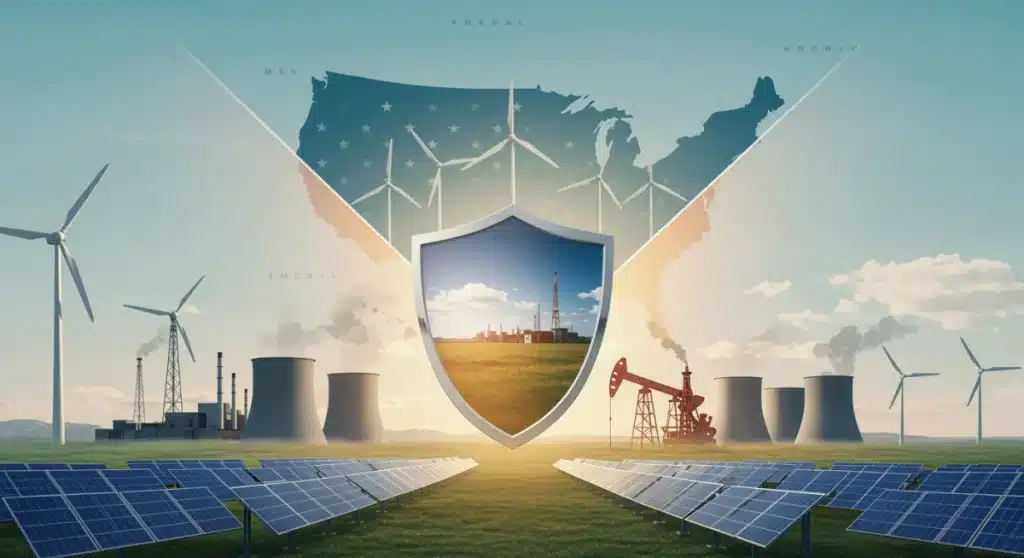2025 Energy Policy: National Security Implications

Comparing the 2025 energy policy proposals reveals diverse strategies for enhancing national security, balancing economic growth, and addressing environmental concerns, all critical for the United States’ future global standing.
The discussion around the United States’ future energy strategy is more critical than ever, with various proposals vying for prominence. These plans, often framed by differing ideological and economic philosophies, all aim to chart a course for the nation’s energy future, but their implications for national security vary significantly. Understanding these differences is key to discerning which path truly offers the best protection for American interests.
The Geopolitical Landscape of Energy
Energy policy is inextricably linked to national security, influencing everything from military readiness to diplomatic leverage. The United States’ energy choices in 2025 and beyond will determine its vulnerability to global supply disruptions, its relationships with energy-rich and energy-poor nations, and its capacity to project power. The geopolitical landscape is constantly shifting, and a robust energy strategy must adapt to these changes while safeguarding core national interests.
Historically, energy dependence has been a significant vulnerability for many nations. For the U.S., achieving a degree of energy independence has long been a goal, aiming to reduce reliance on volatile foreign sources. However, true energy security encompasses more than just domestic production; it also involves diversification of energy types, resilient infrastructure, and strategic alliances.
Energy Independence vs. Energy Security
While often used interchangeably, energy independence and energy security are distinct concepts. Energy independence primarily focuses on domestic production meeting domestic demand. Energy security, on the other hand, is a broader concept encompassing the reliable, affordable, and sustainable supply of energy. A nation can be energy independent but still vulnerable if its domestic supply relies on a single, fragile source or if its infrastructure is susceptible to attack.
- Domestic Production: Reducing reliance on foreign oil and gas.
- Supply Diversification: Utilizing a mix of energy sources (renewables, nuclear, fossil fuels).
- Infrastructure Resilience: Protecting grids and pipelines from cyber and physical threats.
- Strategic Reserves: Maintaining reserves to cushion against sudden disruptions.
The 2025 energy policy proposals often grapple with this distinction, with some prioritizing maximum domestic output and others emphasizing a diversified, resilient system. The choice between these approaches has profound implications for how the U.S. navigates global energy markets and maintains its strategic position. A policy that solely focuses on independence without considering the broader aspects of security might inadvertently create new vulnerabilities.
Proposal A: Accelerated Renewable Transition
One prominent set of proposals advocates for an aggressive transition to renewable energy sources by 2025. Proponents argue that this path not only addresses climate change but also significantly enhances national security by reducing reliance on fossil fuels, which are often sourced from politically unstable regions. This approach envisions massive investments in solar, wind, geothermal, and hydropower, alongside advancements in battery storage and smart grid technologies.
The security benefits of this approach are compelling. By generating a significant portion of its energy domestically from inexhaustible resources, the U.S. would insulate itself from price volatility and supply shocks in international oil and gas markets. This reduces the need for military intervention to secure supply lines and allows for greater diplomatic flexibility.
Key Components of Renewable Transition
Policies under this umbrella typically include substantial tax credits, direct subsidies for renewable energy projects, and mandates for utility companies to increase their renewable portfolio. There’s also a strong emphasis on modernizing the electrical grid to handle distributed generation and bidirectional energy flow, making it more resilient to localized disruptions.
- Investment in Solar and Wind: Large-scale deployment of panels and turbines.
- Grid Modernization: Enhancing resilience and smart technology integration.
- Battery Storage Development: Addressing intermittency challenges of renewables.
- Electric Vehicle Infrastructure: Shifting transportation away from fossil fuels.
While the long-term security benefits are clear, the immediate transition poses challenges. The initial capital investment is substantial, and concerns exist about the reliability of a grid heavily reliant on intermittent sources without sufficient storage. Furthermore, the supply chains for renewable technologies often depend on critical minerals sourced from a limited number of countries, potentially shifting one form of dependence for another. A well-executed transition would need to address these supply chain vulnerabilities through domestic production or diversified sourcing.

Proposal B: Continued Fossil Fuel Dominance with Carbon Capture
Another significant policy proposal centers on maintaining a robust fossil fuel industry, particularly natural gas and oil, while investing heavily in carbon capture, utilization, and storage (CCUS) technologies. This approach emphasizes the economic benefits of existing infrastructure and energy jobs, arguing that a rapid shift away from fossil fuels would destabilize the economy and compromise energy affordability.
Proponents of this strategy highlight the proven reliability and dispatchability of fossil fuels, asserting they provide a stable energy base that renewables cannot yet fully match. From a national security perspective, maintaining strong domestic oil and gas production ensures energy self-sufficiency and provides the U.S. with leverage in global energy markets. This approach also supports the energy needs of key allies who may not have the capacity for a rapid renewable transition.
Technological Advancements and Economic Stability
This policy framework would likely involve continued leasing for oil and gas exploration, streamlined permitting processes, and significant research and development funding for CCUS. The argument is that these technologies can significantly reduce the environmental impact of fossil fuels, making them a viable part of a long-term energy portfolio. Economic stability is a core tenet, aiming to protect jobs in traditional energy sectors while fostering innovation in CCUS.
- Enhanced Oil and Gas Production: Maximizing domestic extraction.
- Carbon Capture Investment: Developing and deploying CCUS technologies.
- Export of LNG: Strengthening energy ties with allies through natural gas exports.
- Strategic Petroleum Reserve Maintenance: Ensuring robust emergency reserves.
The national security implications here include maintaining a powerful energy sector that can respond quickly to global demands and crises. However, critics point to the ongoing geopolitical risks associated with fossil fuels, the potential for continued environmental degradation even with CCUS, and the long-term economic unsustainability of a carbon-intensive economy. The reliance on CCUS, a technology still scaling up, also introduces a degree of risk regarding its effectiveness and cost.
Proposal C: Nuclear Energy Renaissance
A third distinct set of proposals advocates for a significant expansion of nuclear energy capacity. This approach positions nuclear power as a clean, reliable, and high-density energy source that can provide baseload power without greenhouse gas emissions. Proponents argue that nuclear energy offers unparalleled energy security due to its long operational cycles, minimal fuel requirements, and immunity to weather-dependent intermittency.
For national security, a strong nuclear energy sector reduces dependence on both fossil fuels and the critical minerals required for many renewable technologies. It provides a stable, predictable energy supply that is less susceptible to geopolitical pressures or extreme weather events. Furthermore, the technological expertise developed in nuclear power generation often has dual-use benefits, contributing to national defense capabilities.
Challenges and Opportunities in Nuclear Expansion
Policies supporting nuclear expansion typically include streamlined regulatory processes for new reactor construction, financial incentives for advanced reactor designs (like Small Modular Reactors or SMRs), and investments in domestic uranium enrichment capabilities. Addressing public perception and the costs associated with construction and waste disposal remain significant challenges.
The security benefits are substantial: a reliable, carbon-free power source that operates independently of weather patterns. However, the upfront costs and construction timelines for new nuclear plants are considerable. There are also concerns about waste storage and the proliferation risks associated with nuclear materials, although modern security protocols are extremely rigorous. A successful nuclear renaissance would require a long-term commitment and significant public and private investment.
The stability provided by nuclear power can be a cornerstone of national security, offering a non-intermittent power source that bolsters grid resilience. It also fosters a highly skilled workforce and advanced technological capabilities, which are assets to overall national strength. Overcoming the financial and regulatory hurdles will be crucial for this path to realize its full potential.
The Interplay of Energy, Economy, and Environment
Beyond direct national security concerns, each energy policy proposal carries significant economic and environmental implications that indirectly affect national strength. A thriving economy provides the resources for a strong defense, while a stable environment reduces the likelihood of climate-induced migration, resource scarcity, and internal instability. The optimal energy path must balance these three pillars.
The renewable transition (Proposal A) promises long-term economic growth through new industries and jobs, but with potential short-term disruptions to traditional energy sectors. Environmentally, it offers significant greenhouse gas reductions. The fossil fuel dominance approach (Proposal B) aims for economic stability by leveraging existing assets and jobs, with environmental mitigation through CCUS. Nuclear expansion (Proposal C) offers clean energy with economic benefits from high-tech job creation, but with high upfront costs and waste management considerations.
Economic Impacts of Energy Choices
Each policy path will create and eliminate different types of jobs, affect consumer energy prices, and influence international trade balances. A policy that fosters domestic innovation and manufacturing across its energy sector will likely see greater economic benefits and enhanced national security.
- Job Creation: Varies significantly between renewable, fossil, and nuclear sectors.
- Energy Costs: Impact on consumer and industrial electricity/fuel prices.
- Trade Balances: Effect on imports/exports of energy and related technologies.
- Technological Innovation: Driving R&D in specific energy domains.
The environmental aspect is also a security issue. Climate change can exacerbate existing conflicts, create new humanitarian crises, and strain military resources. Therefore, an energy policy that effectively addresses climate change can be seen as a proactive national security measure, reducing future risks and fostering global stability. The challenge lies in finding a balance that ensures both environmental protection and a robust, affordable energy supply.

Assessing National Security Risks and Opportunities
To determine which path offers the best national security, a comprehensive risk-opportunity analysis is essential. Each proposal presents unique vulnerabilities and strengths. The accelerated renewable transition, while offering long-term resilience, faces challenges in grid stability during the transition and potential reliance on foreign critical mineral supply chains. Diversifying these supply chains and investing in domestic processing will be crucial.
The continued fossil fuel dominance approach offers immediate energy abundance and economic stability but maintains exposure to geopolitical volatility in oil and gas markets. It also faces increasing pressure from global climate policies and the long-term costs of carbon emissions. Investing in CCUS to reduce these impacts is a key mitigation strategy, but its widespread deployment is still uncertain.
Mitigating Risks Across Policies
For nuclear energy, the risks include high upfront capital costs, long construction times, and the challenges of waste management. However, its benefits in terms of stable, emissions-free baseload power are substantial. Overcoming regulatory hurdles and fostering public acceptance will be vital for this path to contribute meaningfully to national security.
- Supply Chain Resilience: Reducing reliance on single-source critical materials.
- Cybersecurity: Protecting energy infrastructure from digital attacks.
- Physical Security: Safeguarding power plants, pipelines, and transmission lines.
- Geopolitical Volatility: Adapting to changes in global energy markets.
Ultimately, the best approach for national security might not be a single, monolithic policy but rather a strategic blend that leverages the strengths of each. A diversified energy portfolio, combining reliable baseload power with increasingly abundant renewables, could offer the greatest resilience. This would reduce single points of failure and provide flexibility in responding to unforeseen challenges, whether they are geopolitical, economic, or environmental.
The Path Forward: A Hybrid Energy Strategy
Considering the complexities and interdependencies of energy, national security, economics, and environment, a hybrid energy strategy appears to be the most prudent path for the United States in 2025. Such a strategy would not advocate for an exclusive reliance on any single energy source but rather a diversified portfolio that maximizes strengths and mitigates weaknesses across the spectrum.
This hybrid approach would entail continued investment in renewable energy research and deployment, aiming for significant but realistic growth. It would also recognize the ongoing need for conventional energy sources, particularly natural gas, as a bridge fuel, while aggressively pursuing carbon capture technologies to minimize environmental impact. Crucially, it would include a robust commitment to nuclear power, especially advanced reactor designs, to provide reliable, clean baseload power.
Building a Resilient Energy Future
The goal of a hybrid strategy is to build an energy system that is resilient, affordable, clean, and secure. This means investing in infrastructure that can withstand physical and cyber threats, diversifying supply chains to reduce foreign dependencies, and fostering international partnerships that enhance global energy stability. It’s about strategic foresight, preparing for a future where energy demands continue to grow while environmental imperatives become more pressing.
- Diversified Energy Portfolio: Combining renewables, nuclear, and cleaner fossil fuels.
- Infrastructure Investment: Modernizing grids and protecting critical assets.
- International Cooperation: Collaborating on energy security and technology.
- Domestic Innovation: Fostering U.S. leadership in energy technologies.
By embracing a balanced and adaptable energy policy, the United States can enhance its national security, maintain economic competitiveness, and lead in addressing global climate challenges. This approach acknowledges that there is no single silver bullet, but rather a need for a comprehensive, multi-faceted strategy that evolves with technological advancements and geopolitical realities. The decisions made in 2025 will lay the foundation for decades to come, shaping America’s role in a rapidly changing world.
| Policy Focus | National Security Impact |
|---|---|
| Accelerated Renewables | Reduces geopolitical fossil fuel dependence, long-term stability, but initial grid challenges. |
| Fossil Fuels with CCUS | Maintains energy abundance and economic stability, but ongoing market volatility exposure. |
| Nuclear Energy Expansion | Provides stable, clean baseload power, enhances grid resilience, high upfront costs. |
| Hybrid Strategy | Diversifies sources, balances risks, enhances overall resilience and adaptability. |
Frequently Asked Questions About Energy Policy and National Security
Energy dependence, especially on volatile foreign sources, can expose a nation to supply disruptions, price shocks, and geopolitical leverage from other countries. This can compromise economic stability, military operations, and diplomatic flexibility, making energy independence a critical component of national security strategy.
Renewable energies enhance national security by reducing reliance on imported fossil fuels, mitigating climate change impacts, and diversifying domestic energy sources. This lessens exposure to geopolitical risks and creates a more resilient energy infrastructure, though initial grid integration and mineral supply chains need careful management.
Yes, domestic fossil fuel production provides energy abundance, supporting economic stability and offering strategic leverage. When combined with carbon capture technologies, their environmental impact can be reduced, allowing them to serve as a reliable bridge during the energy transition and support allies’ energy needs.
Nuclear energy is crucial for national security due to its capacity for stable, emissions-free baseload power, independent of weather conditions or fuel imports. It strengthens grid resilience and fosters advanced technological expertise, minimizing vulnerabilities to external energy disruptions and enhancing overall strategic capabilities.
A hybrid energy strategy combines diverse sources like renewables, nuclear, and cleaner fossil fuels. This approach enhances national security by diversifying supply, reducing single points of failure, and improving overall resilience against geopolitical, economic, and environmental shocks, ensuring a robust and adaptable energy future.
Conclusion
Choosing the optimal energy policy for the United States in 2025 is a complex endeavor, demanding a careful balance between economic imperatives, environmental stewardship, and paramount national security concerns. While each proposed path—accelerated renewables, continued fossil fuel reliance with CCUS, and a nuclear renaissance—offers distinct advantages and challenges, a singular focus on any one approach risks neglecting critical vulnerabilities. The most robust strategy for bolstering national security appears to be a well-considered hybrid model. Such an approach would strategically integrate diverse energy sources, prioritize resilient infrastructure, foster domestic innovation, and engage in proactive international partnerships. By doing so, the U.S. can build an energy future that is not only sustainable and affordable but also profoundly secures its strategic interests and global standing in an ever-evolving world.





